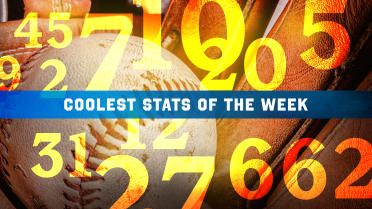Hang Max Fried's curveball in an art gallery, in the Clayton Kershaw wing.
The young Braves starter's left-handed, waterfall hook is a show-stopper, and a kindred spirit to the Kershaw curveball that's been one of the most beautiful pitches in the game for so long.
And don't worry, there's not just form, there's function. Fried's curveball doesn't just look pretty. It's the best pitch thrown by a pivotal piece of the Braves' playoff rotation as they try to make the leap to challenging Kershaw's Dodgers for the National League pennant. There's a lot riding on Fried's performance in October, and his curveball is going to be at the center of everything.
Fried throws his curveball over 25% of the time, on the higher end of starters, and over a third of the time when he's ahead in the count. He's not a Charlie Morton, but his curve is a weapon to attack hitters, not a surprise for special occasions. It's Fried's most-used secondary pitch, ahead of his slider -- a newly developed complement for the curve -- and a smattering of changeups and cutters. He has more strikeouts on curveballs, 63, than on any other pitch.
The numbers on his curve are excellent: a .215 batting average allowed, a .319 slugging percentage, a 41.7% strikeout rate, a 37.0% swing-and-miss rate. And based on the (poor) quality of contact opposing hitters have made, they could be even better -- the expected batting average against Fried's curveball is just .172, the expected slugging just .217.
Let's hope we get to see lots more in October. Here's what makes Fried's curveball what it is:
Big movement
You can tell by watching it arc from hand to mitt: Fried's curveball gets a ton of vertical movement. On average, it drops 69.4 inches on its way to the plate, per Statcast's tracking. That makes it one of the most parabolic curves in baseball.
Curveballs with the most vertical movement
Min. 250 thrown this season
- Chris Bassitt (OAK): 71.4 inches
- Mike Fiers (OAK): 70.8 inches
3) Max Fried (ATL): 69.4 inches
4) Zack Greinke (HOU): 68.9 inches
5) Clayton Kershaw (LAD): 68.2 inches
Part of the reason Fried's curveball drops so much is because it's slow. Averaging 74.6 mph, it often comes in 20 mph or more slower than his fastball, which gives gravity more time to take hold of the pitch. That's also why it's so pleasing to the eye.
But even looking at the pitchers who throw comparable curveballs -- similar speed, release and extension -- Fried stands out.
His curveball drops 7.6 inches more than average. That means it's not just one of the most parabolic curves, it's one of the sharpest in its class.
*Most vertical curveball movement above avg.**
Min. 250 thrown this season
- Trevor Bauer (CIN): +9.4 inches
- Seth Lugo (NYM): +8.9 inches
3-T) Max Fried (ATL): +7.6 inches
3-T) Mike Fiers (OAK): +7.6 inches
5) Walker Buehler (LAD): +7.1 inches
*Avg.: Compared to pitches within 2 mph and 0.5 feet of extension/release point
One other cool thing we can do with Fried's movement data: profile the type of curveball he has.
Fried's curveball moves a lot vertically. But it doesn't move as much horizontally, averaging 9.2 inches of break to its 69.4 inches of drop. While Fried is 7.6 inches above average in his vertical curveball break, he's 1.6 inches below average in his horizontal curveball break. High vertical movement and low horizontal movement? That's the 12-6 style.
Kershaw is the gold standard for 12-6 curveballs. Fried's isn't quite as true 12-6 as Kershaw's, but their curveballs share fundamental swooping brushstrokes.
Fried: 74.6 mph avg. velocity
69.4" vert. movement (+7.6" vs. avg.*)
9.2" horiz. movement (-1.6" vs. avg.)
Kershaw: 73.4 mph avg. velocity
68.2" vert. movement (+3.8" vs. avg.)
3.4" horiz. movement (-6.6" vs. avg.)
*Avg.: Compared to pitches within 2 mph and 0.5 feet of extension/release point
High spin
How does Fried get his curve to move like that? He spins it.
Fried's curveball spin rate: 2,843 rpm
MLB avg.: 2,522 rpm (Fried: 91st percentile)
LHP avg.: 2,452 rpm (Fried: 94th percentile)
Fried's average curveball spin rate of 2,843 rpm is over 300 rpm higher than league average, and nearly 400 rpm higher than the average for MLB lefties. He's hit the elite 3,000+ rpm level 76 times, including on 11 strikeouts.
A high-spin curveball isn't the same thing as a good curveball (Kershaw's, for one, has never had high spin), but higher spin tends to get more movement, and more movement tends to be good. For Fried: his high spin does generate more movement. How do we know that? Thanks to what Statcast calls "active spin."
Active spin is just the percent of a pitch's spin that contributes to its movement. That depends on the spin axis -- the direction the ball is spinning -- essentially, how a pitcher throws his specific version of a pitch. (A true 12-6 curveball, for example, would be rotating straight over the top as it leaves the pitcher's hand and travels toward the batter. The closer the pitcher gets to that spin axis, the more of his spin rate will contribute to 12-6 movement.)
As far as curveballs go, Fried has one of the highest active spin percentages of any pitcher.
Highest active spin % on curveballs
Min. 500 pitches thrown this season
- Rich Hill (LAD): 100.0%
- Joakim Soria (OAK): 98.1%
- Adam Wainwright (STL): 97.9%
- Trevor Bauer (CIN): 97.2%
5) Max Fried (ATL): 95.7%
That's why Fried ranks near the top of both the curveball spin rate and pitch movement leaderboards. And it puts him in a group with some of baseball's most notable curveball throwers in Hill, Wainwright and Bauer.
If the big lefty curveball is Fried's painting, his spin and movement are his materials. They're of the highest quality.
David Adler is a reporter for MLB.com based in New York.




